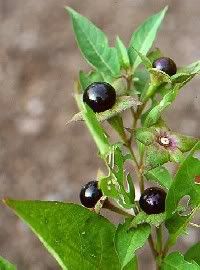

Description: Belladonna is a European perennial naturalized to the eastern United States. It prefers pastures, mountain forests, ruins, and waste places, growing especially luxurious in shady areas. It particularly prefers limey or highly calciferous soil. The thick, creeping, whitish and fleshy root, usually about six inches long, rises to an erect, glabrous, herbaceous stem. The purplish stem is usually three to five feet high and splits into three branches. The dull green ovate leaves are solitary lower on the branches and grow in pairs, one leaf half the size of the other, on higher branches. In June and July, solitary bell-shaped flowers bloom from the axils of leaves, followed by shiny dull brown to dark purple one-inch long fruit. This fruit is sweet, the size of cherry, and full of purple juice. The fresh plant exudes a foul odor when crushed, but this almost disappears in dried plants. The leaves retain a bitter flavor. No part of Belladonna should be consumed for any reason.
Effects: gentle
Planet: Saturn
Element: water
Associated Deities: Hecate, Bellona, Circe, Atropos
Traditions:
Atropos, the third Fate for whom the herb is named, is said to have used belladonna in her duties when snipping the thread of life. The name, Beautiful Lady or Belladonna, comes from Italy. According to lore, women would drop juice into their eyes to dilate pupils.
The Bellonarii, priests of Bellona, a Roman goddess of war and sister to Mars, drank an infusion prior to invoking her aid or worshiping her. The priests dressed in black and honored her at sacrifices by screaming and wounding themselves in the arms and legs. Her temple was outside the city walls and used by the senate to negotiate with foreign ambassadors and receive victorious Roman generals. This is also possibly the plant which poisoned Marc Antony's troops during the Parthian Wars.
During the Middle Ages, Devil was said to watch over the belladonna day and night. The only except was the night of Walpurgis (derived from an 8th century English Saint) which corresponds to Beltane. On this night, he had more important duties to attend to.
Magic:
According to legend, belladonna was one ingredient of the famous “flying ointment.” Belladonna does contain powerful and deadly hallucinogens. It has been applied to spells for astral projection, visions, and rituals of the dead. Due to its connection to Bellona, it has also been used in rituals for preparation before battle.
Known Combinations:
none noted
Two other substances found in Belladonna, scopolamine and hyoscyamine, are used in a number of antispasmodics used to treat intestinal disorders like diarrhea, irritable colon, and peptic ulcers. Belladonna is an anti-spasmodic, a calmative, diaphoretic, diuretic, and narcotic.
Nutrition:
Mercantile Uses:
![]()
![]()
Parts used: leaves, tops, berries
Belladonna contains atropine, scopolamine, and hyoscyamine. These are all chemicals which have found applications in modern medicine. Despite belladonna's strong toxicity, there are several medical uses of its parts...though not suggested for home use. It’s most common name, Belladonna, comes from the fabled use of the plant's juices by Italian ladies, who would drop the juice in their eyes to enlarge their pupils and make their eyes more beautiful. Atropine, a chemical found in belladonna, is used by modern eye doctors to dilate the pupils so they can examine the retina.
none
None aside from medical applications.